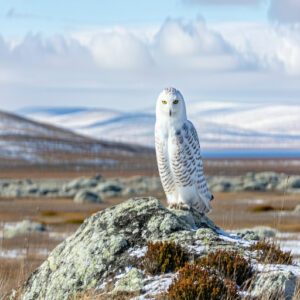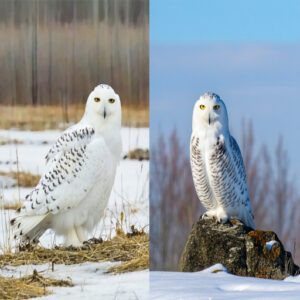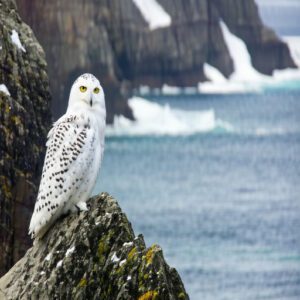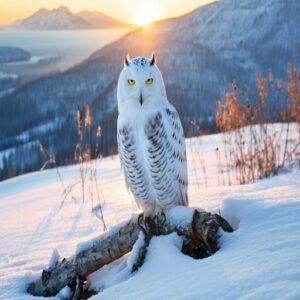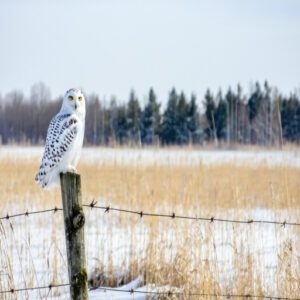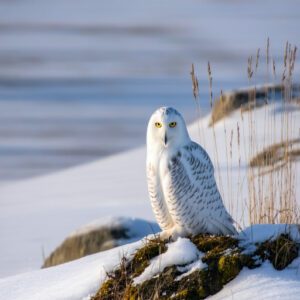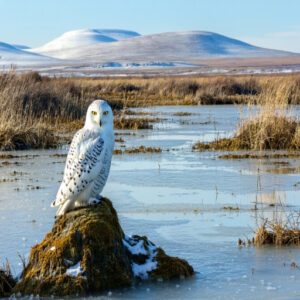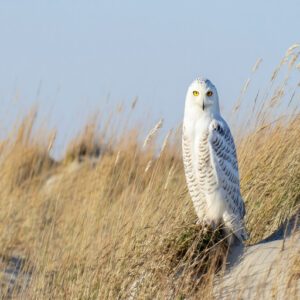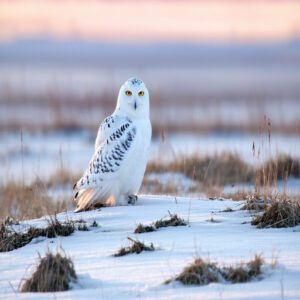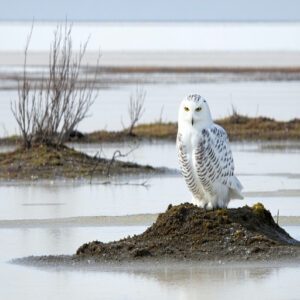This site is supported by our readers. We may earn a commission, at no cost to you, if you purchase through links.
 The habitat of the snowy owl is as fascinating as the bird itself.
The habitat of the snowy owl is as fascinating as the bird itself.
You’ll mostly find these majestic owls in the Arctic tundra, where open, treeless landscapes provide perfect hunting grounds.
They perch on the ground or small hills, scanning for prey like lemmings and other small animals.
In winter, they migrate to southern Canada and the northern U.S., settling in open fields, marshes, or even coastal areas.
Snowy owls are adaptable, thriving in windswept dunes, rolling tundras, and even agricultural fields.
Their Arctic biodiversity habitats suit their needs and also play a significant role in the ecosystem.
Curious about their migration secrets?
Table Of Contents
- Key Takeaways
- Snowy Owl Habitat Overview
- Geographic Distribution Range
- Breeding Grounds Location
- Wintering Areas and Migration
- Year-Round Residency Areas
- Habitat Types and Features
- Circumpolar Region Habitats
- Snowy Owl Nesting Sites
- Territory Defense and Prey Availability
- Climate Change Impacts on Habitat
- Frequently Asked Questions (FAQs)
- What is the main habitat of an owl?
- Why do snowy owls live in the tundra?
- Is the snowy owl in the Arctic?
- What trees do snowy owls live in?
- Why does the snowy owl live in the tundra?
- Where are Snowy Owls most active?
- What temperature do Snowy Owls live in?
- Do Snowy Owls migrate in pairs or groups?
- What do Snowy Owl eggs look like?
- How do Snowy Owls keep warm?
- Conclusion
Key Takeaways
- You’ll find snowy owls in the Arctic tundra, where open, treeless landscapes make hunting and nesting easier.
- In winter, they migrate to southern Canada and northern U.S., adapting to open fields, coastal dunes, and even farmland.
- They prefer ground nesting on small hills or shallow depressions, giving them visibility for spotting prey and predators.
- Climate change threatens their habitats as permafrost thaws and prey availability shifts, making conservation efforts crucial.
Snowy Owl Habitat Overview
You’ll find snowy owls in the Arctic tundra, where they choose open, rolling landscapes with high points near water sources for their hunting grounds.
During winter, these remarkable birds expand their territory from their Arctic home to southern Canada and the northern United States, making themselves at home in coastal dunes, marshes, and even agricultural fields.
Arctic Tundra Environments
You’ll find snowy owls thriving in the harsh Arctic tundra ecosystems, where frozen wetlands and permafrost regions create their perfect home.
These remarkable birds have adapted to the polar microclimates, traversing vast stretches of treeless terrain shaped by extreme temperatures.
The tundra ecosystem provides essential hunting grounds and breeding sites, making it a pivotal focus for arctic wildlife conservation efforts.
It’s here, amidst the stark arctic tundra habitat, where snowy owls truly belong.
Open Rolling Tundras
Roaming across vast arctic tundra habitat, snowy owls thrive in open rolling tundras where they can easily spot prey.
You’ll find these majestic birds surveying their domain from elevated perches in these frozen terrain ecosystems.
- High points offer perfect vantage spots for hunting
- Rolling hills create natural wind barriers for nesting
- Open spaces allow unrestricted flight patterns
- Sparse vegetation makes prey detection easier
- Elevated terrain provides safety from ground predators
The combination of these factors makes the open tundra an ideal location for snowy owls, allowing them to hunt, nest, and protect themselves in a vast arctic environment.
Coastal Areas and Islands
Beyond the rolling tundra, you’ll spot snowy owls making themselves at home along Arctic shores and coastal areas.
These remarkable birds adapt perfectly to coastal ecosystems and island habitats, from rocky cliffs to sandy beaches at sea level.
During coastal migration periods, they’re particularly drawn to spots where land meets sea, often choosing windswept dunes and isolated islands as temporary homes in their snowy owl range.
Geographic Distribution Range
Tracking the snowy owl’s geographic distribution reveals a fascinating pattern that stretches across the northern hemisphere.
You’ll find these magnificent birds primarily above the 60º latitude line, where they’ve adapted perfectly to life in the arctic tundra habitat.
Their range shows impressive latitude variance, spanning from the heart of the Arctic to occasional southern ventures.
Unlike the eastern bluebird range, snowy owls are highly migratory.
These Arctic owls don’t stick to just one spot – their distribution follows regional shifts based on food availability and seasonal changes.
During different seasons, their habitat expands and contracts across the circumpolar north, including territories throughout Greenland, Iceland, and the vast expanse of northern Russia.
Sea ice plays a pivotal role in their Arctic migration patterns, serving as hunting platforms and temporary rest stops.
As climate patterns change, you might notice tundra expansion affecting their traditional ranges, pushing these adaptable birds to explore new territories across their extensive distribution network.
Breeding Grounds Location
You’ll find snowy owls nesting across the vast stretches of the Canadian Arctic Islands, coastal Alaska, Scandinavia, and northern Russia, where they build their homes in the open tundra between 60° and 82° north latitude.
If you’re hoping to spot these magnificent arctic hunters during breeding season, you’ll need to bundle up and head to these northern regions, where they’ve chosen the perfect spots near water sources to raise their young, which is a critical aspect of their survival in the harsh tundra.
Canadian Arctic Islands
The Canadian Arctic Islands, particularly Bylot Island in Nunavut, remain essential breeding grounds where snowy owls thrive in pristine arctic tundra habitat.
These northern shores and island ecosystems support remarkable arctic wildlife populations, especially near areas where sea ice formation meets land.
Throughout these tundra landscapes, you’ll spot these magnificent birds nesting close to open water, perfectly adapted to the harsh yet beautiful environment.
During winter, snowy owls expand their range into southern Canada and the northern United States, with more information on their wintering distribution areas.
Coastal Alaska
Along the pristine Alaska Coastline, you’ll discover snowy owls in increasingly rare breeding colonies.
Their arctic owl habitat spans the windswept tundra near Utqiagvik, where dedicated researchers track nesting pairs each summer.
Researchers observed only one active nest with six eggs, as detailed in this snowy owl update.
In this unique coastal ecosystem, these magnificent birds navigate the delicate balance between sea ice and tundra wildlife, though their numbers have declined by 64% since 1970.
Scandinavia and Northern Russia
Snowy owls nest across the Russian Tundra and Scandinavian Mountains, thriving in the rugged Arctic climate.
This snowy owl habitat showcases frozen forests and open landscapes, perfect for hunting and raising young.
Their reliance on tundra wildlife makes prey abundance essential.
Here, snowy owl distribution is shaped by the vast, snow-covered terrains of the Arctic tundra, which is a key factor in their survival, alongside the availability of tundra wildlife.
Wintering Areas and Migration
When winter arrives, snowy owls migrate to southern Canada and the northern United States, sometimes even reaching sea ice in the Arctic.
You’ll often find them in open fields, coastal areas, and other spots where hunting is easy.
Southern Canada
When the Arctic tundra freezes over, snowy owls seek refuge in southern Canada’s open fields and tundra-like landscapes.
Their wintering patterns bring them to prairie farmland and grassy expanses, blending perfectly with the snowy environment.
As the most adaptable of Canadian wildlife, these Arctic borders become southern habitats, showcasing the impressive owl migration tied to abundant prey in these areas.
Northern United States
If you’re in the United States, especially in snowy owl wintering grounds like New England habitats, the Midwest, or the Pacific Northwest, keep an eye out.
These Arctic birds love open spaces, even urban areas like golf courses.
Oklahoma sightings and Florida encounters happen too during migration, and snowy owl habitats here mimic the Arctic tundra’s open, chilly vibe.
Sea Ice in The Arctic
In frigid Arctic landscapes, snowy owls adapt to the sea ice—a surprising yet fitting winter haven.
Perched along melting ice leads, they hunt seabirds in the frozen tundra ecosystem.
This Arctic owl habitat, shared with polar bears and iceberg ecology, proves essential for their survival, showcasing their resilience in the Arctic ice formation and challenges.
Year-Round Residency Areas
You’ll find snowy owls sticking to northern Canada year-round, especially in areas that double as frequent breeding grounds.
These spots offer plenty of food, open space, and the frigid climate they’re built to withstand.
Northern Canada
You might associate snowy owls with icy tundras, but Northern Canada is their go-to spot year-round.
Think vast, open Arctic Wildlife teeming with life.
The Canadian Tundras, Yukon, and Subarctic Regions give these owls the safety they need.
Here’s why this snowy owl environment works so well:
- Ample prey like lemmings.
- Minimal predator threats.
- Wide spaces for hunting.
- Boreal Ecosystems nearby.
- Habitat stability despite tough winters.
Frequent Breeding Grounds
The snowy owl’s frequent breeding grounds stretch across Arctic landscapes, rooted in tundra ecosystems that provide perfect nesting spots.
These snowy owl breeding grounds, including the Canadian Arctic Islands and coastal Alaska, sit within their northern breeding range.
Unlike snowy owls, golden eagles form lifelong breeding partnerships, exhibiting contrasting mating strategies.
Nesting habits stay simple—just shallow depressions on the ground, often on small hills.
Their presence depends heavily on prey like lemmings, tying their breeding patterns to the abundance of food in these frigid habitats.
Habitat Types and Features
You’ll find snowy owls in a mix of habitats, from the treeless tundra to marshes, dunes, and fields.
These areas offer open spaces and perching spots, making it easier for them to hunt and stay safe.
Tundra and Marshes
The tundra’s formation shapes icy landscapes where snowy owls thrive, blending into open rolling tundra and vast marshes.
These habitats offer Arctic vegetation for cover and hunting, and permafrost dynamics keep it frozen, but wetlands teem with life.
Understanding marsh ecology helps protect these fragile habitats, and the conservation of tundra habitat ecosystems is essential for maintaining the delicate balance of Arctic wildlife.
Snowy owls embrace the wild freedom of these unique ecosystems, mastering survival.
Dunes and Grasslands
In dune ecosystems and grassland habitats, snowy owls thrive where sandy plains meet open skies.
Picture them perched in coastal dunes or scanning Arctic meadows for prey.
These landscapes, with their sparse vegetation, mirror the open rolling tundra they love.
You can find a variety of snowy owl grassland products related to this unique habitat.
Grasslands, like natural hunting arenas, offer visibility and prey, making them essential parts of snowy owl habitat.
Agricultural Fields and Lakeshores
After dunes and grasslands, snowy owls surprise you by settling into agricultural fields and lakeshores.
They perch on fence posts in fields, scanning for prey, or rest along lakes, blending into their surroundings.
These areas aren’t their native Arctic tundra, but they’re prime spots for finding food, thanks to small mammals and birds.
It’s nature adapting, snowy owl style, with a unique approach to survival in new environments, which can be described as prime spots.
Circumpolar Region Habitats
You’ll find snowy owls across the circumpolar regions, where they thrive in the harsh Arctic landscapes of Greenland, Iceland, and northern Europe.
These habitats offer the wide-open spaces and sparse vegetation they need for hunting and nesting.
Greenland and Iceland
In the vast Arctic landscapes of Greenland and Iceland, snowy owls thrive in an unforgiving, magical biome.
The Arctic tundra is a key part of their world, with several distinct features, including:
- Endless Arctic tundra stretching under icy winds.
- Greenlandic wildlife bustling amid minimal vegetation.
- Icelandic tundras as rare viewing spots.
- Towering, snow-capped Nordic ecosystems.
- Polar regions’ crisp, unbroken skies framing their flight.
Nature’s artistry, truly, is on full display in these landscapes, where Greenland’s tundras are a key breeding habitat, while Iceland occasionally hosts these stunning birds.
Northern Europe and Russia
Across the Russian Tundra and Siberian Landscapes, snowy owls thrive in the Arctic climate, blending into vast European habitats.
Northern Scandinavia also offers prime nesting spots for these Arctic tundra birds, from Finland to Norway, their snowy owl biome stretches across Nordic wildlife zones.
Breeding mainly in Russia and Scandinavia, they sometimes venture south during frosty winters, showcasing their adaptability to Europe’s changing seasons and varied landscapes, living in the Arctic climate.
Snowy Owl Nesting Sites
You’ll find snowy owls nesting right on the ground, often in small hills or shallow depressions across the tundra.
These spots give them a clear view of predators and prey, making them perfect for raising their young.
Ground Nesting
How do snowy owls handle nesting? They lay eggs right on the tundra, using no nesting materials—just a shallow scrape in the ground.
This strategy helps them blend into their snowy owl tundra surroundings. But it’s risky, as ground predators, like foxes, threaten nesting success.
Still, their burrow-style system, paired with sharp eyes and fierce defense, helps safeguard the snowy owl breeding grounds remain safe for their young. Understanding the snowy owl habitat is vital for conservation efforts.
Small Hills and Depressions
You’d be surprised how picky snowy owls are about their nesting spots.
They favor small hills or shallow depressions within their Arctic tundra habitat, blending perfectly into the terrain features of open rolling tundra.
These raised spots give them a clear view to guard their nests, while the depression ecology offers shelter from harsh winds.
It’s nature’s version of a sunken living room—practical yet stylish for snowy owl nesting sites!
Territory Defense and Prey Availability
You’ll find that snowy owls fiercely defend their territories, especially when prey like lemmings is plentiful. Their behavior guarantees they can hunt effectively, maintaining control over key feeding grounds.
Solitary Bird Behavior
Being a bit of a loner, the snowy owl thrives in solitude, fiercely guarding its turf.
These birds rely heavily on territorial marking to secure hunting grounds in their nomadic habitats.
Their social interactions are minimal, ensuring prey resources aren’t shared.
Snowy owls employ a variety of territorial defense strategies to protect their hunting grounds.
It’s all about survival: their Arctic tundra adaptations mean they’ll fiercely defend key spots while staying nimble, using clever flight patterns and sharp observational skills to outwit competition.
Diurnal and Crepuscular Hunting
Snowy owls don’t wait for darkness – they’re active during the day and at twilight, perfect for spotting prey in open rolling tundra.
Using keen eyesight and sharp hearing, they rely on hunting strategies like silent flight pursuits or perch-watching.
These snowy owl adaptations make them deadly stalkers.
Crepuscular tactics give them an edge when prey like lemmings emerges, and daytime stalking works effortlessly in their snowy owl habitat.
Climate Change Impacts on Habitat
You’ve probably noticed how warming temperatures are reshaping the Arctic, and snowy owls are feeling the heat too.
Their tundra habitat is shrinking as permafrost thaws and prey patterns shift, making survival even tougher.
Vulnerability to Temperature Changes
A changing climate is throwing snowy owl habitats into a tailspin.
With Arctic warming and temperature fluctuations, these cold-weather specialists face thermal stress as their icy world transforms.
Snowy owl adaptations can’t keep pace with rapid climate shifts, threatening their role in arctic biodiversity.
Shrinking tundras and unstable prey cycles demand snowy owl conservation efforts to secure their future.
A circumpolar species, they symbolize resilience, but survival depends on timely action.
Adaptations for Cold-Weather Survival
It’s no wonder snowy owl adaptations for survival are legendary.
Their Cold Weather Feathers act like built-in parkas, keeping them toasty in brutal Arctic winters.
This Insulating Plumage doesn’t just trap warmth—it’s a perfect Arctic Camouflage, blending seamlessly with snow.
Add sharp Snowy Vision for spotting prey and their clever frosty hunting style, and you’ve got a bird thriving in an Arctic biodiversity haven.
It’s snowy owl behavior and adaptation at its finest!
Frequently Asked Questions (FAQs)
What is the main habitat of an owl?
Picture a land straight out of a winter postcard – wide, open spaces with rolling tundra.
Owls thrive in Arctic tundras, perched near water sources, blending into snow-covered terrain with their crisp white feathers.
Why do snowy owls live in the tundra?
They stick to the tundra because it’s open, flat, and full of their favorite prey—lemmings.
Its wide, rolling landscape makes hunting easy, while the sparse vegetation helps them spot predators or rivals from far away.
Is the snowy owl in the Arctic?
Imagine nature’s version of a snow globe—yes, snowy owls thrive in the Arctic.
These incredible birds rule the icy tundra, surviving freezing temperatures with thick feathers and sharp hunting skills, perfectly built for Arctic life.
They are well adapted to their environment.
What trees do snowy owls live in?
Snowy owls don’t live in trees—they stick to treeless Arctic tundra or open fields.
They prefer wide, open spaces to spot prey and keep an eye on everything, since trees just aren’t their thing.
Why does the snowy owl live in the tundra?
Life in the tund’s like being on nature’s minimalist stage.
You’re built for open spaces, like snowy owls, adapted perfectly with white feathers for camouflage, warmth, and sharp senses to hunt prey in this harsh, treeless environment.
This environment demands unique adaptations for survival.
Where are Snowy Owls most active?
You’ll catch snowy owls most active during the day, especially at dawn and dusk.
They hunt in open areas like fields or tundra, patiently watching from perches, then swooping low to snag their prey.
What temperature do Snowy Owls live in?
Snowy owls thrive in freezing temperatures, often ranging from -40°F to 50°F.
Their thick feathers act like built-in winter coats, keeping them cozy in the harsh Arctic tundra and chilly northern winters.
Do Snowy Owls migrate in pairs or groups?
They don’t stick to pairs or groups when migrating.
Snowy owls typically fly solo, focusing on finding food.
But in areas rich with prey, you might spot a few scattered nearby, tolerating each other’s presence.
What do Snowy Owl eggs look like?
Snowy owl eggs are whitish and roughly the size of a large chicken egg. A clutch usually contains 3 to 11 eggs, sometimes stained from the nest.
How do Snowy Owls keep warm?
Like wearing a built-in winter coat, snowy owls stay warm thanks to their thick, insulating feathers that even cover their legs and toes.
These feathers trap heat, making Arctic chills feel like a breeze.
Conclusion
Did you know snowy owls can roam over 1,500 miles during migration.
Their habitat spans the Arctic tundra, southern Canada, and northern U.S. winters, adapting to open landscapes like fields and coastal areas.
These birds nest on the ground, often near hills for visibility, and thrive in harsh windswept environments.
The habitat of the snowy owl showcases incredible resilience, balancing isolation and migration, and protecting these spaces is essential, as climate change challenges their cold-weather survival.

